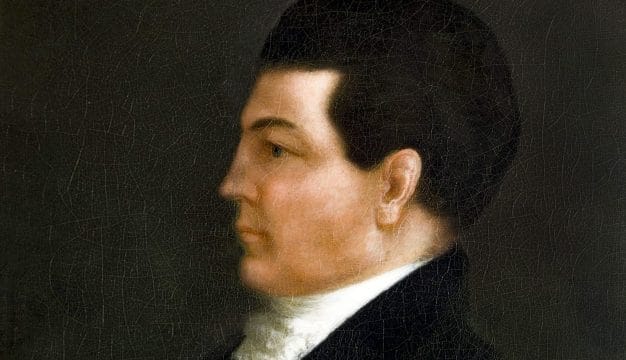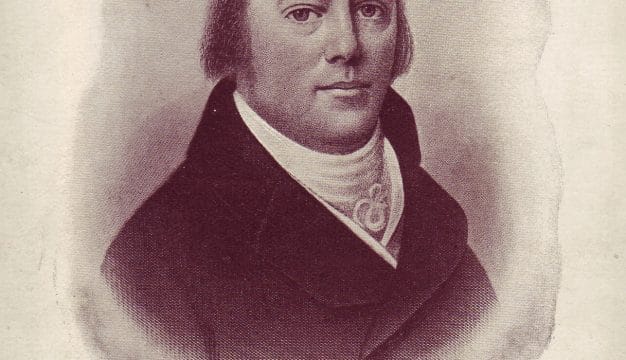Wetumpka
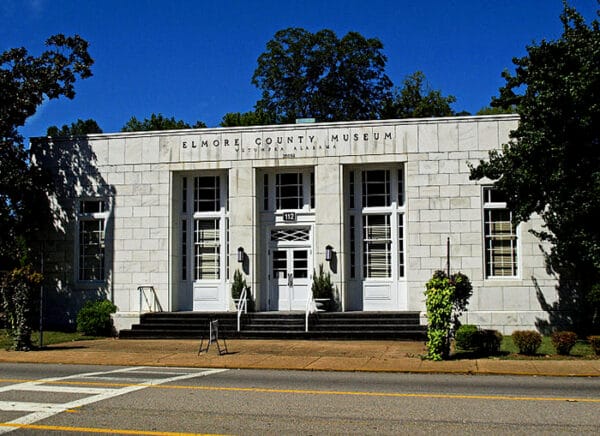 Elmore County Museum
Located in Elmore County, Wetumpka was a judicial and economic stronghold before the Civil War. Selected as county seat in 1866, Wetumpka is still the economic center of Elmore County. Situated on the banks of the Coosa River, Wetumpka provides visitors and residents with a view of the foothills of the Appalachian Mountains. Wetumpka was the setting for several scenes in the 2003 film adaptation of Daniel Wallace‘s 1998 novel Big Fish. It is notable as the site of an impact by a cosmic object some 83 million years ago. The raised outline of the resulting crater‘s edge is visible as a ridge to the east of the city; Bald Knob is the highest point on the rim. Suffragist Frances Griffin was born and raised in Wetumpka. The city has a mayor-council form of government.
Elmore County Museum
Located in Elmore County, Wetumpka was a judicial and economic stronghold before the Civil War. Selected as county seat in 1866, Wetumpka is still the economic center of Elmore County. Situated on the banks of the Coosa River, Wetumpka provides visitors and residents with a view of the foothills of the Appalachian Mountains. Wetumpka was the setting for several scenes in the 2003 film adaptation of Daniel Wallace‘s 1998 novel Big Fish. It is notable as the site of an impact by a cosmic object some 83 million years ago. The raised outline of the resulting crater‘s edge is visible as a ridge to the east of the city; Bald Knob is the highest point on the rim. Suffragist Frances Griffin was born and raised in Wetumpka. The city has a mayor-council form of government.
History
Wetumpka’s history traces its roots back to the Indian, French, and British inhabitants of the area. Originally settled by the Creeks, an Indian village known as Taskigi occupied the area until the French established Fort Toulouse in 1714. Wetumpka was considered part of the French colony of Louisiana and thus was subject to French authority. As British power increased, so did tensions between England and France, resulting in the withdrawal of the French in 1763. No longer a part of Louisiana, Wetumpka was incorporated into the British province of Illinois until 1798. In 1800, the town was considered a part of the Mississippi Territory, and white settlers arrived in increasing numbers. The area came under U.S. control after forces led by Gen. Andrew Jackson defeated the Creeks at the Battle of Horseshoe Bend; Jackson moved into Fort Toulouse, renovated it, and renamed it Fort Jackson.
 Wetumpka Crater Painting
Fort Jackson became the judicial center of the area, and court sessions were held there until 1818, when Montgomery County was created. Originally divided into eastern Wetumpka, in Coosa County, and western Wetumpka, in Autauga County, the city was incorporated in February 1834 (the east side in January 1834, the west side in February 1834). In 1836, an East Coast newspaper declared that Wetumpka (along with Chicago) was one of the most promising cities in what was then referred to as “the West.” By 1841, the state government had completed a penitentiary in Wetumpka; in 1845, when the decision was made to move the state capital from Tuscaloosa, Wetumpka, and Montgomery were the top choices for the new location.
Wetumpka Crater Painting
Fort Jackson became the judicial center of the area, and court sessions were held there until 1818, when Montgomery County was created. Originally divided into eastern Wetumpka, in Coosa County, and western Wetumpka, in Autauga County, the city was incorporated in February 1834 (the east side in January 1834, the west side in February 1834). In 1836, an East Coast newspaper declared that Wetumpka (along with Chicago) was one of the most promising cities in what was then referred to as “the West.” By 1841, the state government had completed a penitentiary in Wetumpka; in 1845, when the decision was made to move the state capital from Tuscaloosa, Wetumpka, and Montgomery were the top choices for the new location.
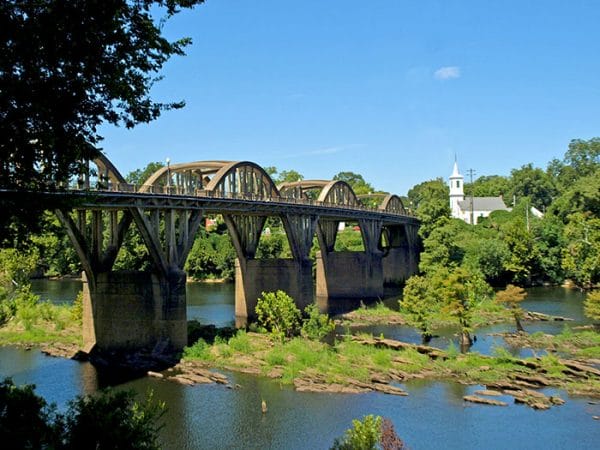 Bibb Graves Bridge in Wetumpka
Like much of the rest of the state, Wetumpka suffered a severe economic downturn during and after the Civil War; its population declined from 3,000 in 1875 to only 619 in 1879. Wetumpka rebuilt itself slowly throughout the early twentieth century. The city built a new jail, established electrical power and a public water supply, replaced wooden-plank sidewalks with concrete ones, and constructed a post office. The Bibb Graves Bridge, completed in 1931, is an important landmark in the town; it was constructed using the rainbow-arch style and is one of only two bridges in Alabama suspended by reinforced concrete. Overcoming fires and floods, by 1950 Wetumpka was the established economic center of the county.
Bibb Graves Bridge in Wetumpka
Like much of the rest of the state, Wetumpka suffered a severe economic downturn during and after the Civil War; its population declined from 3,000 in 1875 to only 619 in 1879. Wetumpka rebuilt itself slowly throughout the early twentieth century. The city built a new jail, established electrical power and a public water supply, replaced wooden-plank sidewalks with concrete ones, and constructed a post office. The Bibb Graves Bridge, completed in 1931, is an important landmark in the town; it was constructed using the rainbow-arch style and is one of only two bridges in Alabama suspended by reinforced concrete. Overcoming fires and floods, by 1950 Wetumpka was the established economic center of the county.
Economic Development
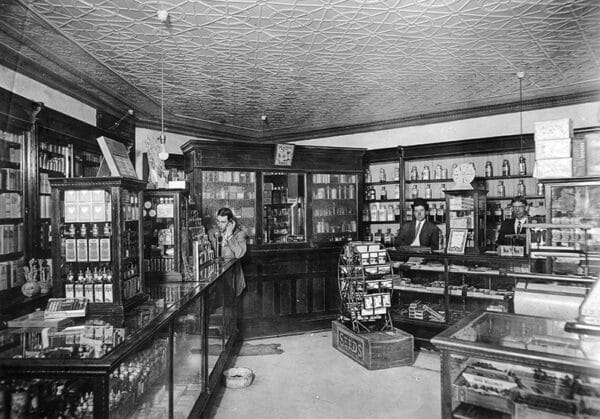 Wetumpka Druggist, 1910
Before the Civil War, Wetumpka imported and exported goods on steamboats plying the Coosa River. After the war, the city was devastated, but unlike other areas, the buildings had not been burned. Wetumpka citizens, however, were left with no money and few possessions. Many were forced to sell their land to pay taxes. Left with nothing but the soil, they had to rely primarily on agriculture. In 1897, the 5th District Agricultural School was built, establishing agriculture as the main economic resource for the city. The school, which would later become Wetumpka High School, provided free scientific instruction in agriculture. In 1906, the L&N Railroad constructed a new depot in Wetumpka, allowing goods to flow in and out of the city more easily. Growth and economic development slowed during World War I but picked up again with the construction of a post office in 1923 and the paving of a road between Montgomery and Wetumpka the following year. A new, larger post office was constructed in 1937. Progress halted again during World War II, but in 1950, the city established a planning board to develop more economic diversity and independence.
Wetumpka Druggist, 1910
Before the Civil War, Wetumpka imported and exported goods on steamboats plying the Coosa River. After the war, the city was devastated, but unlike other areas, the buildings had not been burned. Wetumpka citizens, however, were left with no money and few possessions. Many were forced to sell their land to pay taxes. Left with nothing but the soil, they had to rely primarily on agriculture. In 1897, the 5th District Agricultural School was built, establishing agriculture as the main economic resource for the city. The school, which would later become Wetumpka High School, provided free scientific instruction in agriculture. In 1906, the L&N Railroad constructed a new depot in Wetumpka, allowing goods to flow in and out of the city more easily. Growth and economic development slowed during World War I but picked up again with the construction of a post office in 1923 and the paving of a road between Montgomery and Wetumpka the following year. A new, larger post office was constructed in 1937. Progress halted again during World War II, but in 1950, the city established a planning board to develop more economic diversity and independence.
Demographics
According to 2020 Census estimates, Wetumpka recorded a population of 8,282. Of that number 60.4 percent were white, 33.9 percent African American, 2.0 percent two or more races, 1.9 percent Asian, 1.5 percent Hispanic, and 0.2 percent Native American. The city’s median household income was $46,509, and per capita income was $24,105.
Employment
According to 2020 Census estimates, the workforce in Wetumpka was divided among the following industrial categories:
- Educational services, and health care and social assistance (27.7 percent)
- Arts, entertainment, recreation, accommodation, and food services (18.9 percent)
- Retail trade (16.0 percent)
- Public administration (12.9 percent)
- Manufacturing (7.0 percent)
- Finance, insurance, and real estate, rental, and leasing (6.6 percent)
- Transportation and warehousing and utilities (4.8 percent)
- Construction (2.5 percent)
- Professional, scientific, management, and administrative and waste management services (1.9 percent)
- Wholesale trade (1.1 percent)
- Other services, except public administration (0.5 percent)
- Information (0.2 percent)
Education
Public schools in Wetumpka are part of the Elmore County School System and include two elementary schools, one middle school, and one high school. Three private schools also serve the area.
Transportation
 Jasmine Hill Gardens
Only 12 miles from Wetumpka, Interstate 65 and Interstate 85 provide access to Birmingham and Atlanta, respectively. U.S. Highway 231, mainly used by commuters, runs north-south through the city. Wetumpka is also served by state highways 9, 14, and 111. The Wetumpka Municipal Airport serves general aviation.
Jasmine Hill Gardens
Only 12 miles from Wetumpka, Interstate 65 and Interstate 85 provide access to Birmingham and Atlanta, respectively. U.S. Highway 231, mainly used by commuters, runs north-south through the city. Wetumpka is also served by state highways 9, 14, and 111. The Wetumpka Municipal Airport serves general aviation.
Events and Places of Interest
Wetumpka offers numerous events and attractions for residents and visitors. Fort Toulouse-Fort Jackson National Historic Park offers visitors exhibits and living-history events that trace the site’s 600 years of history. Open year-round, visitors can explore the French and American forts or walk to a Mississippian-period mound site. Once a month, the site hosts living history activities by re-enactors who present life during the French and American periods of the site’s history. Jasmine Hill Gardens offers visitors 20 acres of floral displays and statuary centered around ancient Greek themes.
 Fort Toulouse
The Elmore County Art Guild and Wetumpka Depot Players give visitors the chance to view local art and see plays. The historic Fain Theater was built in the 1930’s and is no longer in service, but it was a popular movie theatre. The Museum of Black History, established by former mayor Jeanette Barrett and other black community leaders, focuses on the histories of Elmore County families, the communities in which they lived, and their churches. The museum is housed in the old Elmore County Training School, built in 1925 for African American students during segregation. The Elmore County Museum, located in a 1937 former post office, is a center of local and regional history and also a research repository.
Fort Toulouse
The Elmore County Art Guild and Wetumpka Depot Players give visitors the chance to view local art and see plays. The historic Fain Theater was built in the 1930’s and is no longer in service, but it was a popular movie theatre. The Museum of Black History, established by former mayor Jeanette Barrett and other black community leaders, focuses on the histories of Elmore County families, the communities in which they lived, and their churches. The museum is housed in the old Elmore County Training School, built in 1925 for African American students during segregation. The Elmore County Museum, located in a 1937 former post office, is a center of local and regional history and also a research repository.

